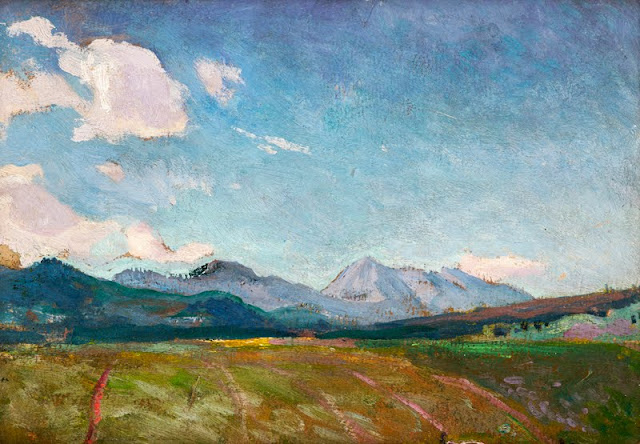STEFAN FILIPKIEWICZ (1879-1944)
Mount Osobita (1,687m - 5,535ft)
Slovakia - Poland border
In Tatra Mountains in Winter, 1910, oil on canvas
The painter
Stefan Filipkiewicz pronounced was a Polish painter and designer, notable for his landscapes inspired by the Young Poland movement. He was a leading representative of the Polish art nouveau style of painting.
His landscapes of the Tatra Mountains and the region of Podhale were first exhibited in Kraków in 1899 at the Palace of Art run by the Kraków Society of Friends of Fine Art. Between 1900 and 1908 Filipkiewicz studied at the Academy of Fine Arts in Kraków under Józef Mehoffer, Leon Wyczółkowski, Jan Stanisławski and Józef Pankiewicz.
In 1908, Filipkiewicz joined the Society of Polish Artists. He became the contributing artist to the legendary Zielony Balonik art-and-literary cabaret. In 1929, Filipkiewicz was awarded the Golden Medal of the Universal Exhibition in Poznań. Four years later, he was also awarded by the Polish Academy of Skills for his works. During the 1939 Invasion of Poland he fled to Hungary, where he became an active member of several underground organizations. Arrested by the Gestapo, he was sent to the Mauthausen-Gusen concentration camp where he was murdered.
Stefan Filipkiewicz pronounced was a Polish painter and designer, notable for his landscapes inspired by the Young Poland movement. He was a leading representative of the Polish art nouveau style of painting.
His landscapes of the Tatra Mountains and the region of Podhale were first exhibited in Kraków in 1899 at the Palace of Art run by the Kraków Society of Friends of Fine Art. Between 1900 and 1908 Filipkiewicz studied at the Academy of Fine Arts in Kraków under Józef Mehoffer, Leon Wyczółkowski, Jan Stanisławski and Józef Pankiewicz.
In 1908, Filipkiewicz joined the Society of Polish Artists. He became the contributing artist to the legendary Zielony Balonik art-and-literary cabaret. In 1929, Filipkiewicz was awarded the Golden Medal of the Universal Exhibition in Poznań. Four years later, he was also awarded by the Polish Academy of Skills for his works. During the 1939 Invasion of Poland he fled to Hungary, where he became an active member of several underground organizations. Arrested by the Gestapo, he was sent to the Mauthausen-Gusen concentration camp where he was murdered.
The mountain
Osobitá (1,687m- 5,535ft) as its name tells ("the lonely one")
is a lonely top in the northern part of the Western Slovak Tatra
Mountains, about 17 km from Zakopane (Poland). It is not very high, but
very distinct and far from the main Tatra ridge. Osobitá constitutes a
distinct geomorphological unit which represents just by itself 12% of
the surface of the Slovak Western Tatras. This moutain was mentioned as
early as 1615 when Polish highlanders described the Polish Tatras (wider
during this time) as extending "From Osobita to Hawran".
There are the three distinct but close tops with heights of 1,617, 1,521 and 1,587 m (the last two are separated by the pass "sedlo pod Osobitou".
There many caves in this karst zone, not all yet been investigated. In
1997, the most famous are Bezdenna and Okolik. Here also, as in many
other places in the Tatra Mountains, was a mining activity for iron.
Now, from these times remain only few tunnels reaching dozens of meters
deep.
In the past, the mountain was an important pastoral center, with five
wide meadows. In the seventeenth century it could host up to 1500 head
of sheep and cows. Later it decreased.
Osobitá separates 3 valleys: Zuberska Dolina, Blatna Dolina and Oravicka
Sucha Dolina. No other summit of the Orava region is as clearly
visible, and very early the mountain attracted a lot of visitors. The
first recorded visit was made by Titus Chałubiński in 1870, the first
recorded winter one by Mariusz Zaruski with companions in 1906.
At the beginning of the twentieth century, there was even a mountain hut
at Mala Osobitá (1,583 m). Since 1989, the top is no longer available
for tourists, since this one is included in the nature reserve (458
hectares). There are two ways to reach Osobitá, from Slovakia and from
Poland. Both are very easy and without difficulty, but the first one is
as short as the second is very long.
Nowadays, it is impossible the reach the real top of Osobitá, which is
located in the Natura 2000 zone, in order to protect fragile fauna such
as eagles. Hence, strictly forbidden as mentionned previously. Including
with a guide, or holding an UIAA licence !___________________________
2020 - Wandering Vertexes...
by Francis Rousseau


